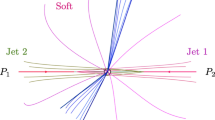Abstract
In this paper, using soft-collinear effective theory, we study the invariant mass distribution for dijet production in \(e^+e^-\)-annihilation. Near threshold, where the dijet takes most of the energy, there arise the large threshold logarithms, which are sensitive to soft gluon radiations. To systematically resum the logarithms, we factorize the scattering cross-section into the hard, the collinear, and the soft parts. And we additionally factorize the original soft part into the global soft function and the two collinear-soft functions, where the latter can be combined with the collinear parts to form the fragmentation functions to jet (FFJs). The factorization theorem derived here can be easily applicable to other processes near threshold. Using the factorized result, we show the resummed result for the dijet invariant mass to the accuracy of next-to-leading logarithms. We have also obtained the result in the case of the heavy quark dijet and compared it with the case of the light quark.


Similar content being viewed by others
Notes
If we consider the dijet production at the LHC, the relevant global soft function can be obtained by subtracting the csoft contributions to the parton distribution functions as well as to the FFJs in the final states [11].
References
C.W. Bauer, S. Fleming, M.E. Luke, Phys. Rev. D 63, 014006 (2000). https://doi.org/10.1103/PhysRevD.63.014006. arXiv:hep-ph/0005275 [hep-ph]
C.W. Bauer, S. Fleming, D. Pirjol, I.W. Stewart, Phys. Rev. D 63, 114020 (2001). https://doi.org/10.1103/PhysRevD.63.114020. arXiv:hep-ph/0011336 [hep-ph]
C.W. Bauer, D. Pirjol, I.W. Stewart, Phys. Rev. D 65, 054022 (2002). https://doi.org/10.1103/PhysRevD.65.054022. arXiv:hep-ph/0109045 [hep-ph]
C.W. Bauer, S. Fleming, D. Pirjol, I.Z. Rothstein, I.W. Stewart, Phys. Rev. D 66, 014017 (2002). https://doi.org/10.1103/PhysRevD.66.014017. arXiv:hep-ph/0202088 [hep-ph]
A.V. Manohar, I.W. Stewart, Phys. Rev. D 76, 074002 (2007). https://doi.org/10.1103/PhysRevD.76.074002. arXiv:hep-ph/0605001 [hep-ph]
J.-Y. Chiu, A. Jain, D. Neill, I.Z. Rothstein, Phys. Rev. Lett. 108, 151601 (2012). https://doi.org/10.1103/PhysRevLett.108.151601. arXiv:1104.0881 [hep-ph]
J.-Y.Chiu, A. Jain, D. Neill, I. Z. Rothstein, JHEP 05,084, https://doi.org/10.1007/JHEP05(2012)084arXiv:1202.0814 [hep-ph]
C.W. Bauer, F.J. Tackmann, J.R. Walsh, S. Zuberi, Phys. Rev. D 85, 074006 (2012). https://doi.org/10.1103/PhysRevD.85.074006. arXiv:1106.6047 [hep-ph]
T. Becher, M. Neubert, L. Rothen, D.Y. Shao, Phys. Rev. Lett. 116, 192001 (2016). https://doi.org/10.1103/PhysRevLett.116.192001. arXiv:1508.06645 [hep-ph]
Y.-T. Chien, A. Hornig, C. Lee, Phys. Rev. D 93, 014033 (2016). https://doi.org/10.1103/PhysRevD.93.014033. arXiv:1509.04287 [hep-ph]
N. Kidonakis, G. Oderda, G.F. Sterman, Nucl. Phys. B 525, 299 (1998). https://doi.org/10.1016/S0550-3213(98)00243-0. arXiv:hep-ph/9801268
J. Chay, C. Kim, Phys. Rev. D 97, 094024 (2018). https://doi.org/10.1103/PhysRevD.97.094024. arXiv:1710.02284 [hep-ph]
T. Kaufmann, A. Mukherjee, W. Vogelsang, Phys. Rev. D 92, 054015 (2015). https://doi.org/10.1103/PhysRevD.92.054015. arXiv:1506.01415 [hep-ph]
Z.-B. Kang, F. Ringer, I. Vitev, JHEP 10, 125, https://doi.org/10.1007/JHEP10(2016)125arXiv:1606.06732 [hep-ph]
L. Dai, C. Kim, A.K. Leibovich, Phys. Rev. D 94, 114023 (2016). https://doi.org/10.1103/PhysRevD.94.114023. arXiv:1606.07411 [hep-ph]
L. Dai, C. Kim, A.K. Leibovich, Phys. Rev. D 95, 074003 (2017). https://doi.org/10.1103/PhysRevD.95.074003. arXiv:1701.05660 [hep-ph]
S. Catani, Y.L. Dokshitzer, M.H. Seymour, B.R. Webber, Nucl. Phys. B 406, 187 (1993). https://doi.org/10.1016/0550-3213(93)90166-M
S.D. Ellis, D.E. Soper, Phys. Rev. D 48, 3160 (1993). https://doi.org/10.1103/PhysRevD.48.3160. arXiv:hep-ph/9305266 [hep-ph]
Y.L. Dokshitzer, G.D. Leder, S. Moretti, B.R. Webber, JHEP 08, 001, https://doi.org/10.1088/1126-6708/1997/08/001arXiv:hep-ph/9707323 [hep-ph]
M. Cacciari, G.P. Salam, G. Soyez, JHEP 04, 063, https://doi.org/10.1088/1126-6708/2008/04/063arXiv:0802.1189 [hep-ph]
W.M.-Y. Cheung, M. Luke, S. Zuberi, Phys. Rev. D 80, 114021 (2009). https://doi.org/10.1103/PhysRevD.80.114021. arXiv:0910.2479 [hep-ph]
S.D. Ellis, C.K. Vermilion, J.R. Walsh, A. Hornig, C. Lee, JHEP 11, 101, https://doi.org/10.1007/JHEP11(2010)101arXiv:1001.0014 [hep-ph]
J. Chay, C. Kim, I. Kim, Phys. Rev. D 92, 034012 (2015). https://doi.org/10.1103/PhysRevD.92.034012. arXiv:1505.00121 [hep-ph]
P. Hinderer, F. Ringer, G.F. Sterman, W. Vogelsang, Phys. Rev. D 91, 014016 (2015). https://doi.org/10.1103/PhysRevD.91.014016. arXiv:1411.3149 [hep-ph]
L. Dai, C. Kim, A.K. Leibovich, JHEP 09, 109, https://doi.org/10.1007/JHEP09(2018)109arXiv:1805.06014 [hep-ph]
L. Dai, C. Kim, A.K. Leibovich, JHEP 09, 148, https://doi.org/10.1007/JHEP09(2021)148arXiv:2104.14707 [hep-ph]
C. Kim, J. Korean Phys. Soc. 77, 469 (2020). https://doi.org/10.3938/jkps.77.469. arXiv:2008.02942 [hep-ph]
G.P. Korchemsky, A.V. Radyushkin, Nucl. Phys. B 283, 342 (1987). https://doi.org/10.1016/0550-3213(87)90277-X
I.A. Korchemskaya, G.P. Korchemsky, Phys. Lett. B 287, 169 (1992). https://doi.org/10.1016/0370-2693(92)91895-G
M. Dasgupta, G.P. Salam, Phys. Lett. B 512, 323 (2001). https://doi.org/10.1016/S0370-2693(01)00725-0. arXiv:hep-ph/0104277 [hep-ph]
A. Banfi, G. Marchesini, G. Smye, JHEP 08, 006, https://doi.org/10.1088/1126-6708/2002/08/006arXiv:hep-ph/0206076 [hep-ph]
M. Balsiger, T. Becher, A. Ferroglia, JHEP 09, 029, https://doi.org/10.1007/JHEP09(2020)029arXiv:2006.00014 [hep-ph]
C. Bierlich et al., SciPost Phys. Codeb. 2022, 8 (2022). https://doi.org/10.21468/SciPostPhysCodeb.8. arXiv:2203.11601 [hep-ph]
M. Neubert, (2007), arXiv:0706.2136 [hep-ph]
M. Fickinger, S. Fleming, C. Kim, E. Mereghetti, JHEP 11, 095, https://doi.org/10.1007/JHEP11(2016)095arXiv:1606.07737 [hep-ph]
Acknowledgements
This study was supported by the Research Program funded by Seoul National University of Science and Technology.
Author information
Authors and Affiliations
Corresponding authors
Additional information
Publisher's Note
Springer Nature remains neutral with regard to jurisdictional claims in published maps and institutional affiliations.
Rights and permissions
Springer Nature or its licensor (e.g. a society or other partner) holds exclusive rights to this article under a publishing agreement with the author(s) or other rightsholder(s); author self-archiving of the accepted manuscript version of this article is solely governed by the terms of such publishing agreement and applicable law.
About this article
Cite this article
Kim, C., Kwon, T. Dijet invariant mass distribution near threshold. J. Korean Phys. Soc. (2024). https://doi.org/10.1007/s40042-024-01075-x
Received:
Revised:
Accepted:
Published:
DOI: https://doi.org/10.1007/s40042-024-01075-x



